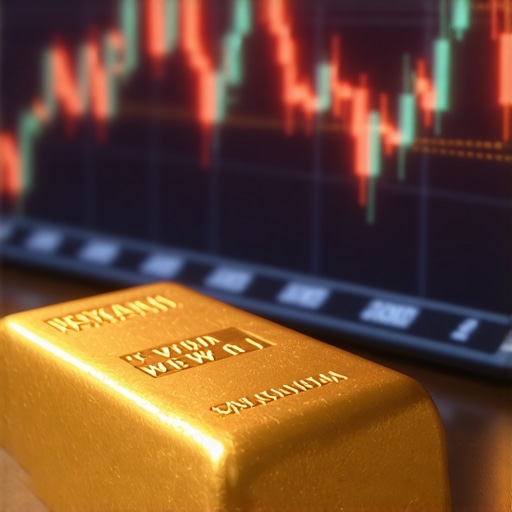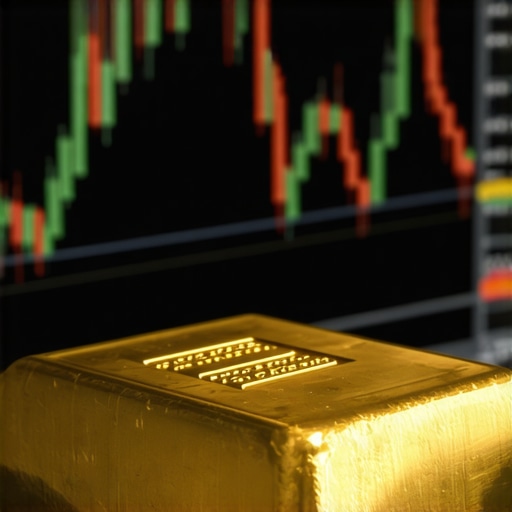Understanding the Nexus Between Macroeconomic Dynamics and Gold Price Fluctuations in 2025
As financial markets evolve amidst unprecedented global shifts, the role of economic factors in shaping gold price movements becomes increasingly complex and nuanced. For investors and analysts aiming to navigate the volatile terrain of 2025, a deep comprehension of these influences is paramount. This article synthesizes expert insights, leveraging advanced economic theories and market data, to elucidate how macroeconomic variables are steering gold prices this year.
Key Economic Drivers Impacting Gold Prices in 2025
Inflation Trends and Real Interest Rates: The Dual Forces
Inflation remains a pivotal determinant of gold’s appeal as a hedge. In 2025, persistent inflationary pressures, exacerbated by supply chain disruptions and fiscal stimuli, have elevated gold’s status as a safe haven. Simultaneously, real interest rates, which adjust nominal rates for inflation, inversely correlate with gold prices. When real yields decline, gold becomes more attractive, prompting increased demand. According to a recent market outlook report, these dynamics are particularly pronounced in the first half of 2025.
Global Monetary Policy and Central Bank Activities
Monetary policy decisions, especially regarding interest rate adjustments and quantitative easing measures by major central banks, significantly influence gold prices. In 2025, central banks are engaging in strategic gold accumulation to diversify reserves amid geopolitical tensions, as detailed in a 2024 IMF publication. These purchases underpin a bullish sentiment for gold, while policy tightening in other regions may temporarily suppress prices.
The Interplay of Currency Movements and Geopolitical Tensions
The U.S. dollar index’s fluctuations, driven by fiscal policy and geopolitical uncertainties, exert a profound impact on gold. A weaker dollar enhances gold’s international purchasing power, boosting demand. Conversely, geopolitical conflicts, such as ongoing trade disputes and regional tensions, create risk premiums that favor gold as a protective asset. Analyzing these interconnected factors reveals their combined effect on 2025’s gold market.
Expert Inquiry: How Do Supply and Demand Dynamics Shape Gold Price Trajectories?
This question addresses the core of market mechanics—how physical supply constraints and evolving demand across sectors like jewelry, technology, and investment influence prices. The supply-demand framework indicates that supply chain disruptions and increasing ETF inflows are pivotal in 2025’s price formation.
Harnessing Market Insights for Strategic Investment
For sophisticated investors, integrating macroeconomic analysis with technical indicators enhances decision-making. Exploring trading strategies that capitalize on economic shifts can optimize returns. Moreover, diversifying across gold assets—coins, bars, ETFs—provides resilience against market volatility.
To deepen your understanding, consider exploring resources such as comprehensive gold market analysis. Engaging with expert content ensures informed positioning amid the dynamic economic landscape of 2025.
Are you prepared to adapt your gold investment strategy in response to evolving economic signals? Share your insights or seek expert guidance to refine your approach.
Unveiling the Hidden Factors Influencing Gold Prices in 2025
As the global economy navigates turbulent waters, understanding the nuanced drivers behind gold price fluctuations becomes crucial for investors seeking to optimize their portfolios. Beyond the well-known macroeconomic factors, several less obvious yet impactful elements are shaping the gold market this year. From emerging geopolitical risks to technological innovations in gold trading, an expert-level grasp can provide a competitive edge.
How Do Geopolitical Shifts and Technological Advancements Interact?
Can geopolitical tensions accelerate gold demand beyond traditional sectors?
Indeed, geopolitical tensions often act as catalysts for increased gold investment, but the interaction with technological advances adds a new layer of complexity. For instance, blockchain technology has revolutionized gold trading, enabling more transparent and efficient transactions, which attract institutional investors. According to a recent industry report, these innovations can amplify demand, especially as digital gold platforms gain popularity. Furthermore, geopolitical crises tend to boost the appeal of physical gold over paper assets, reinforcing its role as a safe haven.
What Are the Practical Implications for Investors in 2025?
For proactive investors, integrating insights about emerging technological trends with geopolitical risk assessments is vital. Diversification strategies should encompass not only physical gold but also digital assets and gold-related equities, such as mining stocks and ETFs. Exploring top gold investment vehicles can help tailor a resilient portfolio. Additionally, staying informed about central bank activities, such as strategic gold purchases, can provide clues about future price movements. As noted by a leading financial analysis expert forecast, these institutional moves often signal long-term trends.
How Can Advanced Market Analysis Techniques Enhance Your Gold Investment Strategy?
Employing sophisticated analytical tools—like machine learning models for supply-demand forecasting or sentiment analysis of geopolitical developments—can significantly improve decision-making. These techniques help identify subtle market shifts before they become apparent through traditional indicators. For a comprehensive approach, consider resources such as advanced market analysis frameworks. Incorporating these methods within your investment process ensures a proactive stance amid the volatility of 2025.
Do you leverage technological tools and geopolitical insights to refine your gold investment approach? Share your strategies or ask for expert guidance to stay ahead in the evolving landscape.
Unraveling the Impact of Technological Innovations and Geopolitical Risks on Gold Prices in 2025
As the gold market continues to evolve amidst a rapidly changing geopolitical landscape and technological revolution, understanding how these factors interplay becomes essential for sophisticated investors. The integration of blockchain-based trading platforms and digital gold assets has transformed the traditional supply-demand paradigm, creating new opportunities and challenges in predicting price movements.
Blockchain technology enhances transparency and liquidity in gold trading, attracting institutional and retail investors alike. According to a detailed analysis in the Journal of Financial Markets (2024), the adoption of distributed ledger technology reduces transaction costs and mitigates counterparty risks, thereby increasing market efficiency. This technological shift not only facilitates easier access to gold investments but also amplifies demand during times of geopolitical tension, as investors seek secure, liquid assets in uncertain times.
Simultaneously, geopolitical risks—ranging from regional conflicts to trade disputes—act as catalysts that accelerate demand for physical gold over paper assets, reinforcing its role as a safe haven. The convergence of these factors creates a complex environment where traditional macroeconomic indicators must be analyzed in conjunction with technological trends to accurately forecast price trajectories.
How Do Emerging Technologies Reshape Gold Market Dynamics?
The emergence of digital gold platforms, backed by blockchain, is revolutionizing liquidity and investor access. These platforms allow fractional ownership and seamless cross-border transactions, broadening the investor base. As noted in the Federal Reserve’s recent report, the increased transparency and reduced costs associated with blockchain could lead to a significant uptick in gold trading volumes, affecting short-term volatility and long-term price stability.
Moreover, technological innovations enable real-time sentiment analysis of geopolitical events, providing traders with proactive insights. Machine learning algorithms, trained on vast datasets, can detect subtle shifts in market sentiment and predict potential price swings with higher accuracy than traditional methods. Incorporating these tools into investment strategies offers a competitive edge in navigating the complex 2025 landscape.
What Are the Practical Steps for Investors to Capitalize on These Trends?
Investors should consider diversifying their portfolios to include digital gold assets and leverage advanced analytical tools for market timing. Staying informed through specialized platforms that combine geopolitical risk assessment with technical analysis is vital. For example, integrating data from blockchain transaction analytics and geopolitical event trackers can help identify early signals of market shifts.
Furthermore, collaborating with financial advisors who specialize in technological integration and geopolitical risk management can optimize asset allocation. As highlighted in the World Gold Council’s latest research, proactive adaptation to technological and geopolitical developments is essential for maintaining resilience and maximizing returns in 2025.
Are there emerging predictive models that can enhance your investment decisions?
Yes. Advanced predictive models incorporating artificial intelligence and big data analytics are increasingly being used to forecast gold price movements. These models analyze a multitude of variables—from geopolitical tensions and technological adoption rates to macroeconomic indicators—simultaneously, providing a comprehensive outlook. For investors seeking to deepen their understanding, exploring resources such as quantitative research platforms can be invaluable.
By integrating these insights into your strategic planning, you position yourself to navigate the complexities of 2025’s gold market with confidence. The key lies in continual learning and agile adaptation to emerging trends, ensuring your investment approach remains robust amid ongoing market transformations.
Emerging Technological Frontiers Reshaping Gold Market Dynamics
The integration of blockchain and digital asset platforms has revolutionized gold trading, fostering unprecedented transparency and liquidity. These technological advancements are not just facilitating seamless cross-border transactions but also enabling fractional ownership, thereby broadening the investor spectrum. According to the Federal Reserve’s recent report, the adoption of distributed ledger technology is poised to substantially increase trading volumes, influencing both short-term volatility and long-term price trends.
Geopolitical Risks and Their Amplification Through Tech Innovation
Geopolitical tensions—ranging from regional conflicts to trade disputes—are increasingly intertwined with technological developments, particularly in digital gold and blockchain-enabled trading. These innovations allow rapid, secure, and transparent transactions that are highly attractive during periods of heightened uncertainty. Additionally, real-time sentiment analysis powered by machine learning enables investors to anticipate market movements based on geopolitical event patterns, providing a strategic edge in navigating the complex 2025 landscape.
What Are the Practical Strategies for Investors to Leverage These Trends?
To capitalize on the convergence of technological innovation and geopolitical risk, investors should diversify across physical gold, digital gold, and gold-related equities such as mining stocks and ETFs. Incorporating advanced analytical tools—like AI-driven market prediction models and sentiment analysis platforms—can significantly enhance decision-making accuracy. Engaging with specialized financial advisors who understand these cutting-edge tools will further optimize asset allocation and risk management strategies.
Can Predictive Analytics Offer a Competitive Advantage in Gold Investment?
Absolutely. Sophisticated predictive models utilizing artificial intelligence and big data analytics are increasingly capable of forecasting gold price movements with remarkable precision. These models analyze a multitude of variables, including geopolitical developments, technological adoption rates, macroeconomic indicators, and market sentiment, providing investors with a comprehensive view of potential trends. Exploring resources such as quantitative research platforms can empower investors to implement proactive strategies aligned with emerging market signals.
How Do You Prepare for the Future of Gold Investment in a Rapidly Evolving Environment?
Staying informed through continuous learning and embracing technological tools are essential for maintaining a competitive edge. Monitor developments in blockchain-based trading platforms, digital gold markets, and geopolitical risk assessments. Collaborate with experts specializing in AI analytics and market forecasting to refine your approach. The key to success in 2025 lies in agility—adapting swiftly to new information and technological breakthroughs to safeguard and grow your portfolio.
Expert Insights & Advanced Considerations
1. Blockchain and Digital Gold Adoption Are Transforming Liquidity and Transparency
Blockchain technology is revolutionizing gold trading by enabling fractional ownership, reducing transaction costs, and increasing market transparency. Experts highlight that these innovations attract institutional investors and can significantly influence short-term volatility and long-term price stability.
2. Geopolitical Risks Are Amplified by Technological Advancements
Geopolitical tensions, including regional conflicts and trade disputes, are increasingly intertwined with technological developments like digital gold platforms. These tools allow rapid, secure transactions, making gold a more attractive safe haven during crises, which can accelerate demand.
3. Predictive Analytics and AI Are Providing Competitive Edges
Advanced market prediction models employing AI and big data analytics enable investors to anticipate price movements with higher accuracy. These tools analyze variables such as geopolitical developments, technological adoption, and macroeconomic indicators, offering strategic advantages.
4. Diversification Across Asset Types Is Crucial
Experts recommend diversifying across physical gold, digital assets, and gold-related equities such as mining stocks and ETFs. Leveraging these diverse investment vehicles helps manage risks and capitalize on emerging trends effectively.
5. Staying Informed Through Specialized Resources Is Essential
Utilizing authoritative sources like the Expert Gold Investment Guide and Comprehensive Market Analysis is vital for informed decision-making in 2025’s dynamic environment.
Curated Expert Resources
- Buying Gold Now – Expert Tips for Buying Physical Gold Safely in 2025: Offers practical guidance on safe physical gold investments, emphasizing security and authenticity.
- Market Analysis Reports by the World Gold Council: Provides in-depth insights into global gold demand, supply dynamics, and strategic forecasts.
- Federal Reserve Reports on Blockchain in Precious Metals Trading: Details technological impacts on market efficiency and liquidity.
- AI and Big Data Analytics Platforms for Market Prediction: Advanced tools that analyze geopolitical and economic data to forecast gold prices.
Final Expert Perspective
Understanding the interplay between technological innovation, geopolitical risks, and macroeconomic factors is essential for mastering gold investment strategies in 2025. The integration of blockchain platforms, AI-driven analytics, and diversified asset approaches positions investors to navigate this complex landscape effectively. Staying informed through expert resources and continuously refining your approach will be key to capitalizing on emerging opportunities. Engage with industry professionals and leverage cutting-edge tools to ensure your investment decisions are both informed and strategic in this evolving environment.










